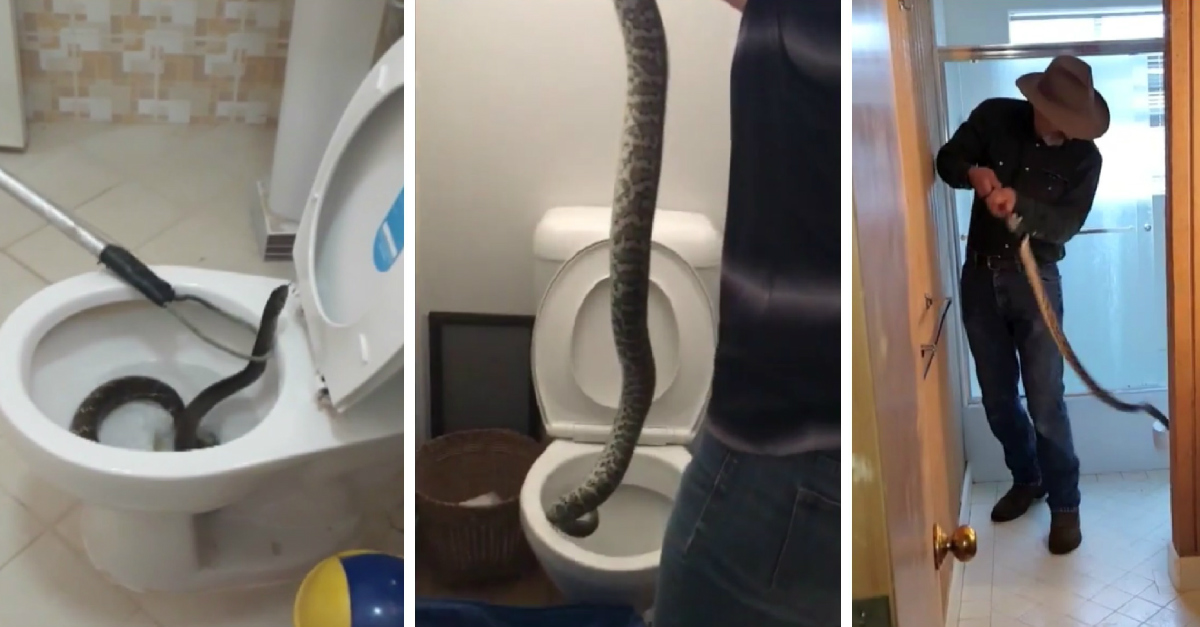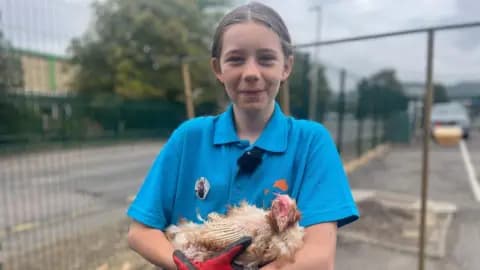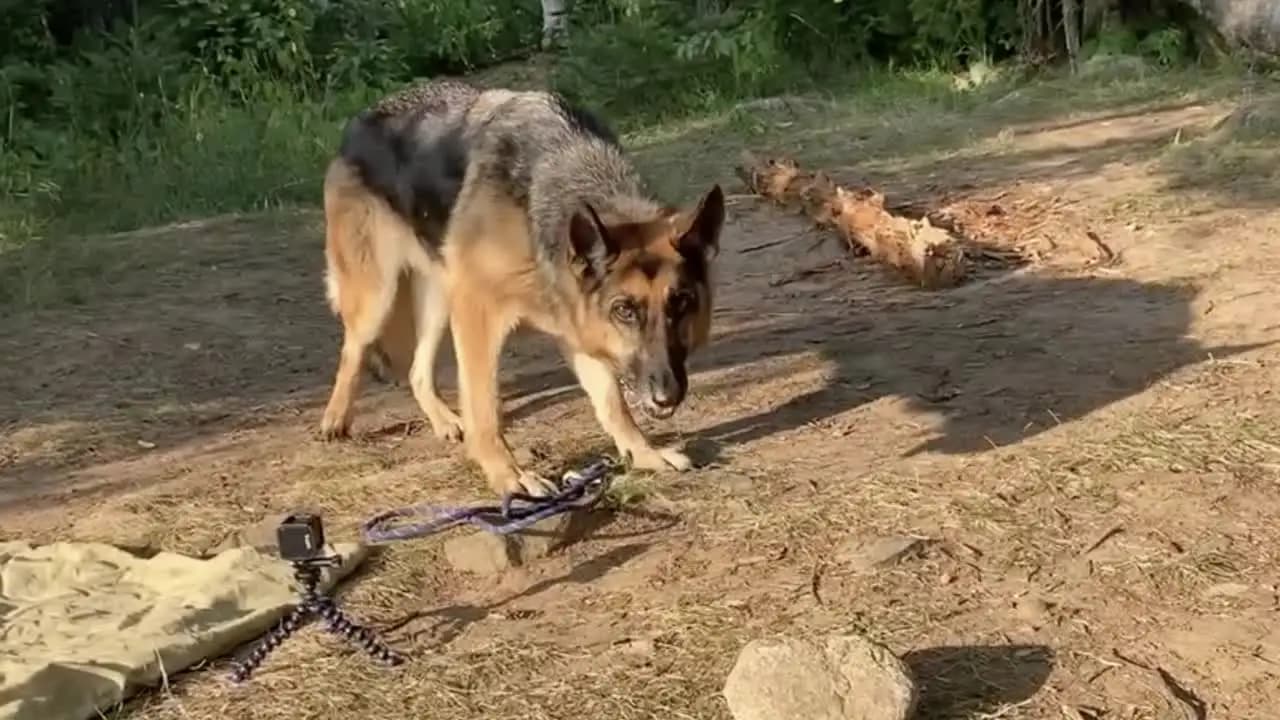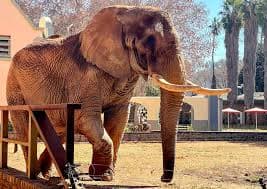
Amazing
Why More People Are Finding Snakes Hiding in Their Toilet
Sitting down on the toilet and then realizing there is a snake in there. It’s a scene from a horror movie and can be anyone’s worst fear. Snakes hiding in toilets are becoming more and more common.
The latest story making the headlines is from Mike Green in North Carolina, who says he has pulled six snakes out of his toilet in the past four years. This is not the only example. Country singer Brett Eldredge recently shared that he walked in the bathroom where he was staying on vacation in the Bahamas and found a snake in the toilet bowl. There are plenty of stories of pythons hiding out in toilets in Australia.
There is a reason why this is happening. A former plumber and curator of reptiles at the Los Angeles Zoo is sharing the reason. He says that snakes are sleek animals and it’s easy for them to fit into tight spaces in their current environment. Snakes feel more at home when they are in a dark, tight space. When they get into a pipe, they feel good about it and it’s easy to navigate through the sewer system and then find their way up the pipes into someone’s toilet. Snakes get in through the ventilation pipes on the roof. Since the bathroom plumbing is usually connected through the ventilation pipes the snake slithers its way through the system and into the bathroom. It’s easy for snakes to slither up anything that will lead them to the roof, such as a tree. If you have a tree that is close to your roof and the ventilation pipe then it can increase your chances of having a snake in the bathroom
If you are wondering what to do if a snake gets in your toilet, know that flushing it away won’t work. If you do find a snake in your toilet then call animal control. Animal control can help you get rid of the snake but can also identify the snake. While the good news is that most snakes are harmless, there is a chance you could have a dangerous one. Don’t be a hero and handle it yourself, just in case it is dangerous.
If you want to avoid snakes in your toilet, there are simple things you can do. Find a way to make sure the ventilation is covered but that it is still able to do the job it is intended to do. By having some sort of block, such as wire covering and mesh, it not only prevents snakes from getting in but also other pests, like rats. You can also install a roof vent hood. These hoods help protect the venting and keep any creepy pests out. Who would have thought that you actually needed to take care of issues on the roof in order to prevent snakes from slithering through the pipes? If you are truly worried then you can invest in a multi-flap that fits over the toilet pipe and allows waste and water to exit but keeps critters out.
Keep in mind if you live in an area that is prone to snakes then this issue may be more common and you may already know how to deal with it. Many snakes that find their way into a toilet are not native to the area where they were found. It’s likely they escaped or were let free by their owners that no longer wanted them and they choose your pipes as a nest. Many snakes aren’t able to survive in the main sewer pipe for very long since there can be relatively low temperatures below the ground where pipes are located, making it unlikely that they actually set up their home in a main sewer line.
Amazing
Utah Woman Donates Kidney to Man She Met on a Hike

In an inspiring turn of events, a Utah County woman donated her kidney to a man she had only recently met on a hike.
Krissy Miller crossed paths with Shiller Joseph while hiking on Y Mountain, near Brigham Young University, in September 2023. During their chance meeting, Miller, a 49-year-old mother of four, learned that Joseph was in desperate need of a kidney. Without hesitation, she offered one of hers. Following medical tests, it was confirmed that they were a compatible match.
The story took an even more heartwarming turn when, after their initial encounter, Miller presented Joseph with what appeared to be a box of rolls. But inside the box was a sign that revealed her incredible gift — she would be his kidney donor.
On Monday, the pair reunited at Intermountain Health in Murray after a successful transplant surgery. Their emotional meeting came after months of preparation and surgery that gave Joseph, 45, a new chance at life.
Joseph, who has lupus, had been on the kidney transplant waiting list for some time. The average wait time for a kidney transplant in the U.S. is three to five years, with more than 90,000 people currently waiting for a life-saving organ. The National Kidney Foundation estimates that around 20 people die each day while waiting for a transplant, underscoring the critical need for organ donors.
Miller’s decision to donate her kidney without hesitation showcases the profound impact one person can make in the face of overwhelming need. This act of kindness not only saved Joseph’s life but also shines a spotlight on the importance of organ donation.
Amazing
A Young Hero for Hens

Harriet, a 12-year-old from Chart Sutton, Kent, is making a difference in the lives of farm hens. Every Saturday morning, she volunteers with Fresh Start For Hens, a local charity dedicated to finding new homes for commercial egg-laying hens.
These hens, typically 72 weeks old, are often destined for slaughter when their egg production declines. However, Fresh Start For Hens buys them from farms and rehomes them as pets.
At collection points like the one in Aylesford, Harriet helps transfer over 100 hens from farms to their new owners. The charity ensures potential adopters provide suitable living conditions for the hens, requiring photos of coops and runs, along with a minimum donation of £2.75 per bird.
Many of these hens arrive in poor condition, sometimes even bald from stress-induced feather pecking. Harriet explains, “They get quite bored, so they peck each other and rip out their feathers.” Remarkably, after a few weeks in their new homes, most hens regain their feathers.
Harriet’s dedication earned her the BBC Young Reporter award. She hopes her story will inspire more farmers to choose rehoming over slaughter for their hens. As Harriet puts it, “It makes me feel proud that I can do something for these chickens, save their lives and give them to these happy families.”
The charity operates entirely on volunteer efforts. Petrina Thomas, who leads collection mornings, believes they’re all motivated by a simple principle: “the love of hens.”
Amazing
Social Media Miracle: Stranger’s Selfless Act Saves Baby’s Life

Amazing human kindness helped give a six-month-old girl named Helin Dinlera second chance at life. It’s all thanks to the generosity of a stranger who responded to an urgent online plea. Helin, diagnosed with a rare and life-threatening liver condition called Biliary Atresia, faced a grim prognosis without a liver transplant.
When no family members were found to be suitable donors, Helin’s mother, Anna Shushura, turned to social media in a desperate attempt to find help. Her emotional appeal caught the attention of Letty Fenlon, a 27-year-old show jumper from Yorkshire, who felt compelled to act.
Letty, already registered as an organ donor, underwent extensive testing and was confirmed as a match for Helin. Despite the risks associated with major surgery, Letty’s determination to help prevailed. In May, she underwent a six-hour procedure to donate a portion of her liver to the infant.
The transplant was successful, and now, at nine months old, Helin is thriving. While she still requires regular medical check-ups, her progress has been remarkable. Helin’s family expresses immense gratitude towards Letty, whose selfless act has given their daughter a chance at a normal life.
Amazing
Trust and Perseverance: The Remarkable Rescue of Lessie from the Boundary Waters

A heartwarming tale of survival and rescue has emerged from Minnesota’s Boundary Waters, where a German Shepherd named Lessie was found after being lost for 55 days. This story highlights the importance of trust-building and community effort in reuniting lost pets with their families.
Lessie’s ordeal began when she escaped following a car accident on the Gunflint Trail near Grand Marais in late June. The Retrievers, a non-profit organization dedicated to finding missing dogs, immediately mobilized to assist in the search.
After a month of uncertainty, hope was rekindled when Lessie was spotted near Ham Lake, miles from the accident site. A Minneapolis-based volunteer, familiar with the area, stepped up to help. Armed with guidance from The Retrievers and his previous experience, he set up camp to search for Lessie.
The volunteer’s patient approach proved crucial. Using food and a trail camera, he gradually gained Lessie’s trust over several days. His persistence paid off when he finally managed to leash Lessie and lead her to safety, facilitating an emotional reunion with her owners.
Jennifer Cadigan of The Retrievers emphasized the intelligence and resilience of dogs, noting that Lessie likely survived on discarded fish remains from nearby campsites. This remarkable story serves as an inspiring reminder to never lose hope when searching for a lost pet.
The successful rescue of Lessie after nearly two months in the wilderness underscores the effectiveness of combining community involvement, expert guidance, and unwavering determination in resolving missing pet cases.
Amazing
Freedom at Last: Charlie the Elephant Begins New Life After Four Decades in Captivity

A momentous event in South African wildlife conservation has unfolded with the release of Charlie, the country’s last zoo elephant, into a natural habitat after 40 years of confinement. This historic transition marks the end of an era for elephant captivity in South African zoos and represents a significant victory for animal welfare advocates.
Charlie’s journey began in 1984 when he was taken from Zimbabwe’s Hwange National Park as a two-year-old calf. His life in captivity included years of performing in a circus before being transferred to South Africa’s national zoo in the early 2000s. During his time at the zoo, Charlie reportedly experienced the loss of four fellow elephants, including his own offspring.
The push for Charlie’s release gained momentum in recent years as concerns about his well-being grew. Animal welfare organizations, including the EMS Foundation and Four Paws, played crucial roles in negotiating with the South African government and providing scientific evidence of the detrimental effects of captivity on elephants.
After a tense four-hour journey, Charlie arrived at his new home in the Shambala Private Reserve in Limpopo province. This 10,000-hectare sanctuary, known for its success in reintegrating animals into the wild, now hosts Charlie as he begins his rehabilitation process.
Veterinary and behavioral experts are closely monitoring Charlie’s adaptation to his new environment. Early signs are promising, with reports of Charlie showing excitement upon hearing other elephants and attempting to communicate with them. However, the rehabilitation process is expected to be gradual, allowing Charlie to rediscover his natural instincts and potentially integrate with the reserve’s existing elephant population.
This release not only signifies a new chapter for Charlie but also represents a broader shift towards improved animal welfare practices in South Africa. As the country continues to grapple with challenges facing its wild elephant population, including poaching and habitat loss, Charlie’s story serves as a reminder of the importance of conservation efforts and the ethical treatment of wildlife.
-

 OMG6 years ago
OMG6 years agoA Couple Gave Birth to the Most Beautiful Twins Ever
-

 OMG7 years ago
OMG7 years ago20 Rare Historical Photos
-

 OMG6 years ago
OMG6 years agoHilarious Airport Photos
-

 Cute6 years ago
Cute6 years agoMom Refuses to Let Daughter Eat Sugar and Years Later This is What She Grows Into
-

 OMG6 years ago
OMG6 years agoTop Secret Air Force One Facts That You Never Knew
-
OMG6 years ago
The Funniest Yearbook Photos Of All Time
-

 OMG6 years ago
OMG6 years agoRetired Mathematician Restores Log Cabin
-

 OMG5 years ago
OMG5 years agoWhat Happened When This ‘Duck Dynasty’ Legend Chopped Off His Beard?